How To Turn Off Windows Security Warning
How to disable Open File security alarm on Windows 10/xi
past Milan Stanojevic
- Eager to discover a quick way to disable Open up File security alert on Windows 10? That'south precisely what we have for y'all.
- To make that happen, change your Internet options. You may also disable User Account Control.
- Feel free to visit our Windows 10 Settings section to notice several easy to empathize tips and tricks.
- Don't forget to bookmark this Tech Tutorials Hub to exist one click away from professional assistance at whatsoever hour.
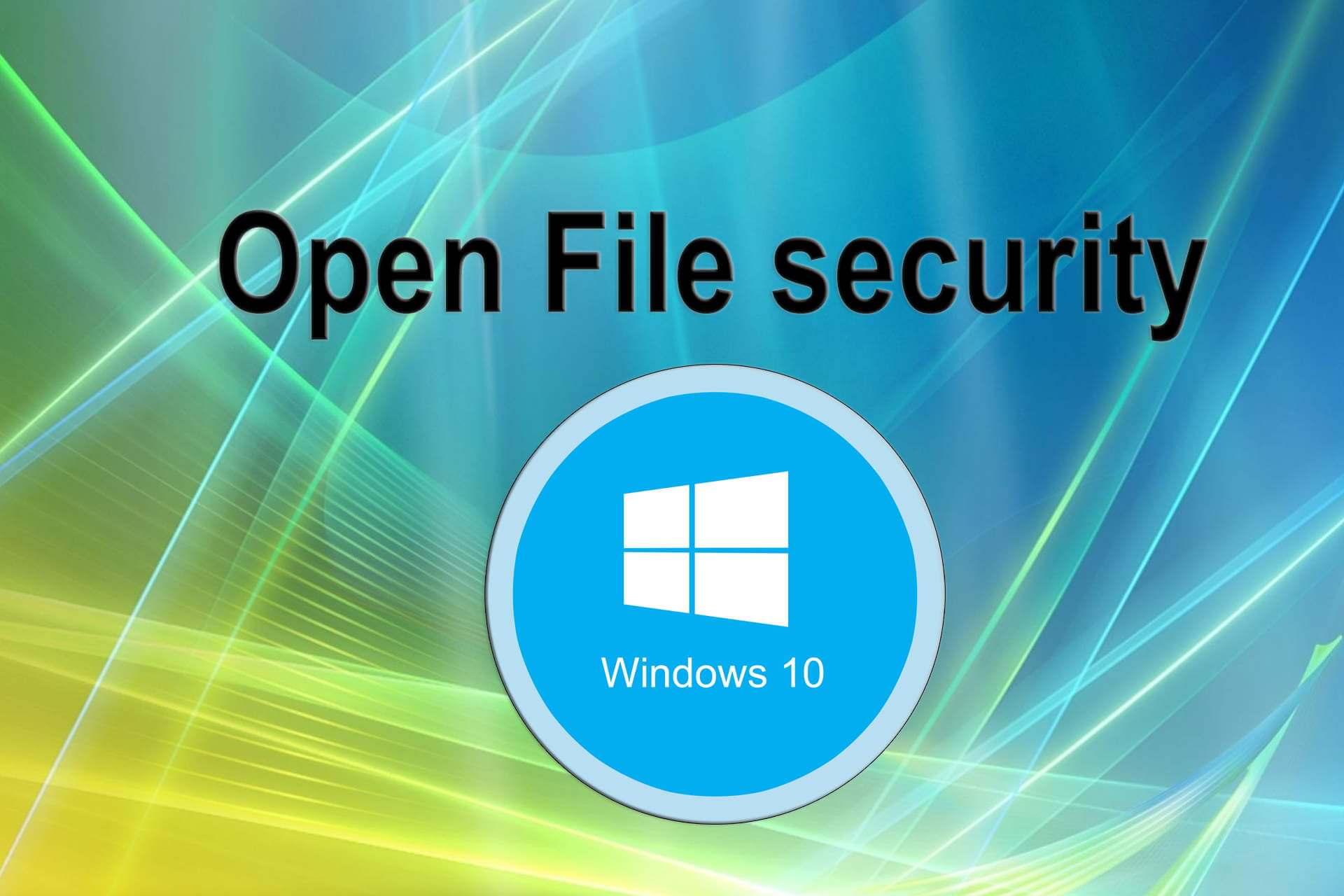
XINSTALL Past CLICKING THE DOWNLOAD FILE
Your online security is rather important, then getting a message that states Your Cyberspace security settings prevented one or more files is nada out of the ordinary.
How many times have you tried to scan freely, simply to receive a message like this? You lot know the answer to that better than anyone else.
Open up File security warnings can be a chip abrasive, and in this article, we'll show you how to easily disable them on Windows x.
How can I disable Open File security warning on Windows 10?
1. Change your Cyberspace options
- Press Windows Central + S and enter Internet options. Select Internet Options from the list of results.
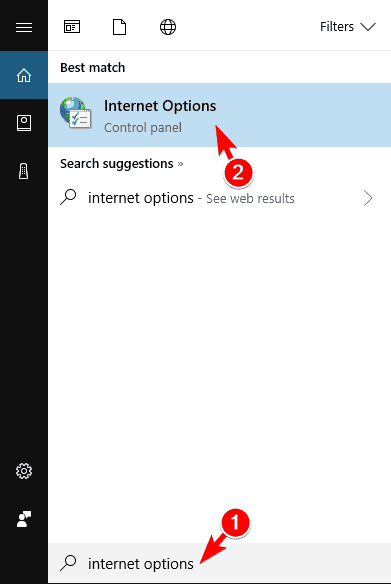
- When the Net Properties window opens, become to the Security tab and click on the Custom Level button.
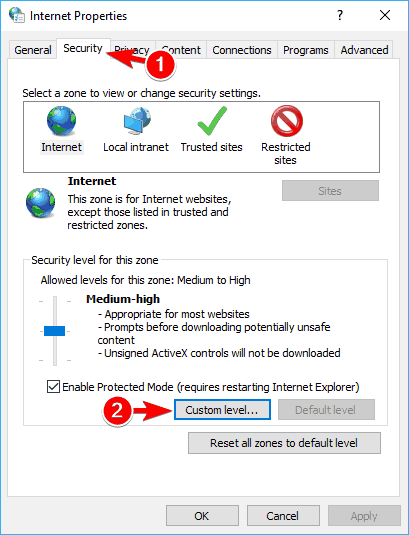
- A listing of settings will announced. Locate Launching applications and dangerous files and select Enable. Now click OK to salvage changes.
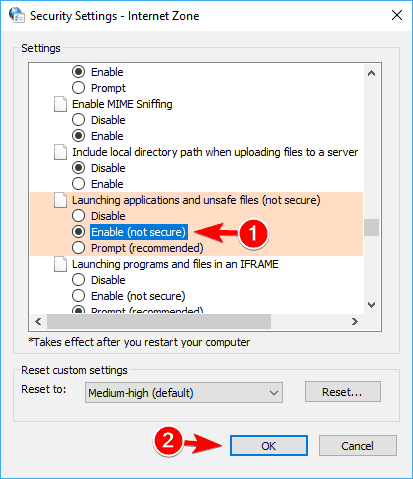
Open File security warning usually appears when trying to run downloaded files, simply you can ready this problem simply past changing your Net options.
This is relatively simple and you can do it by post-obit the above steps. Later on irresolute these settings you should be able to run downloaded files without whatsoever problems.
2. Disable User Account Control
- Press Windows Primal + S and enter user. Select Change User Account Control settings from the carte du jour.
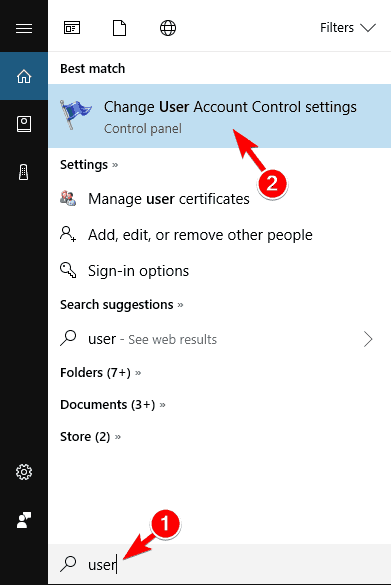
- When User Account Control Settings window appears, move the slider all the way downwardly to Never notify. Click on OK to relieve changes.
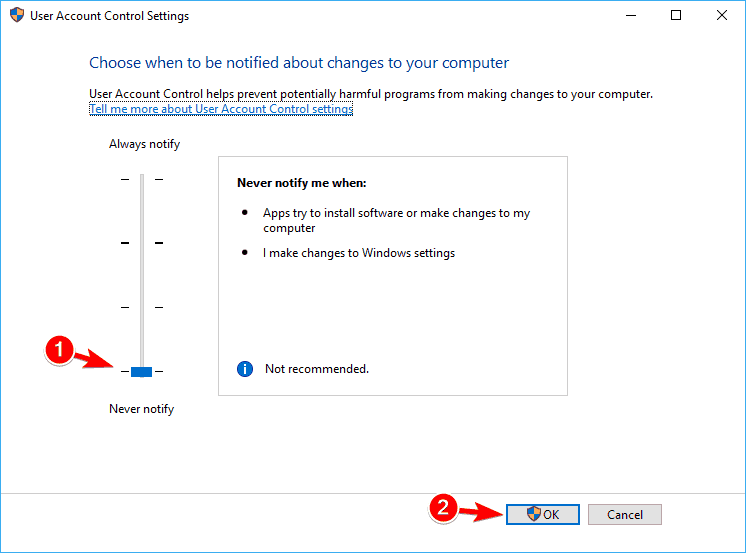
Once you disable User Business relationship Control, you should see fewer security warnings on your PC. Disabling User Account Control won't greatly reduce your security, then you lot can disable it without fearfulness.
If you lot're often getting an Open File security alarm, you might be able to disable information technology past turning off User Account Command.
This is a security feature of Windows that notifies you lot when trying to change a setting or perform an action that requires administrative privileges.
Users claim that this feature is the cause behind this security alarm, and if y'all want to disable information technology, you need to plough off User Account Control.
This guide will assistance yous become an expert in managing User Business relationship Command!
3. Modify your registry
- Press Windows Primal + R and enter regedit. Printing Enter or click OK.
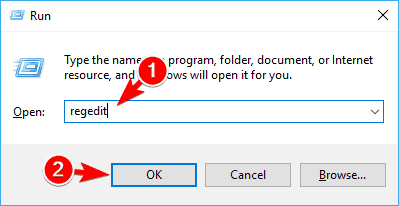
- When Registry Editor opens, get to File > Export.
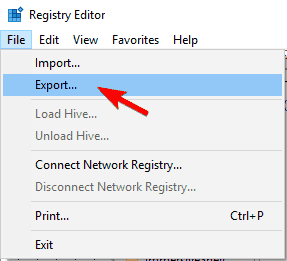 Select All as Export range, enter the desired File name, choose a safe location and click on Save.
Select All as Export range, enter the desired File name, choose a safe location and click on Save.
 In case anything goes wrong afterwards modifying your registry, y'all can easily restore it by running the exported file.
In case anything goes wrong afterwards modifying your registry, y'all can easily restore it by running the exported file. - Navigate to the Associations key. If this fundamental isn't available, you'll demand to create it. To practice that, merely right click the Policies central and choose New > Key from the menu.
 Now enter Associations as the proper name of the key and navigate to information technology.
Now enter Associations as the proper name of the key and navigate to information technology. - In one case you navigate to Associations key, look for LowRiskFileTypes in the right pane. If this value isn't available, you'll need to create it manually. To do that, right-click the empty space in the correct pane and choose New > Cord Value from the menu.
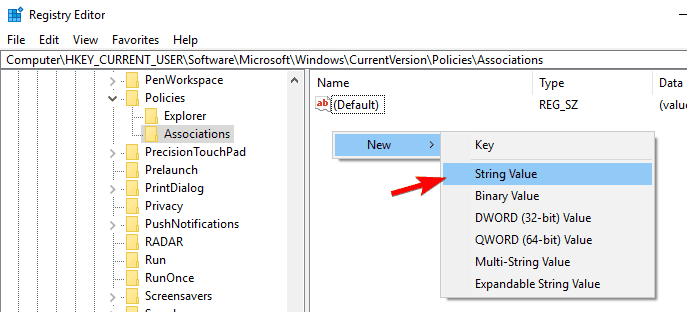 Enter LowRiskFileTypes every bit the name of the string. Double click the LowRiskFileTypes to open up its properties.
Enter LowRiskFileTypes every bit the name of the string. Double click the LowRiskFileTypes to open up its properties. - When the Properties window opens, paste the following into the Value data field:
.avi;.bat;.cmd;.exe;.htm;.html;.lnk;.mpg;.mpeg;.mov;.mp3;.mp4;.mkv;.msi;.m3u;.rar;.reg;.txt;.vbs;.wav;.zip;.7z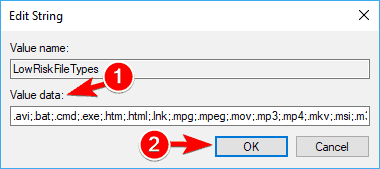 If needed, you can add more extensions in order to disable the security alarm for them. After y'all're washed, click on OK.
If needed, you can add more extensions in order to disable the security alarm for them. After y'all're washed, click on OK. - After making the changes, close Registry Editor and restart your PC.
Your registry holds sensitive arrangement information, and past modifying information technology y'all can disable this security warning from appearing.
Modifying the registry can exist potentially dangerous if you're not careful, so we advise you to be extra cautious.
Once your PC restarts, the problem should be fixed and you won't encounter the security alert anymore.
If yous don't want to manually edit your registry, you tin download Disable_Open-File_Security_Warning.reg file and run it.
By doing that, you'll disable the security warning for the specified file types. In instance you desire to enable the security alert, but download Enable_Open-File_Security_Warning.reg and run information technology.
4. Edit your Group Policy
- Press Windows Fundamental + R keyboard shortcut and enter gpedit.msc. Printing Enter or click OK.
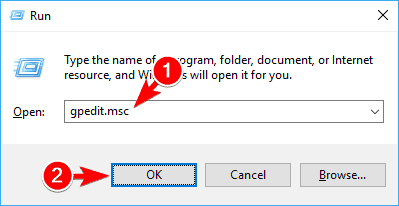
- In the left pane navigate to User Configuration > Administrative Templates > Windows Components > Zipper Director. In the right pane locate Do not preserve zone information in file attachments.
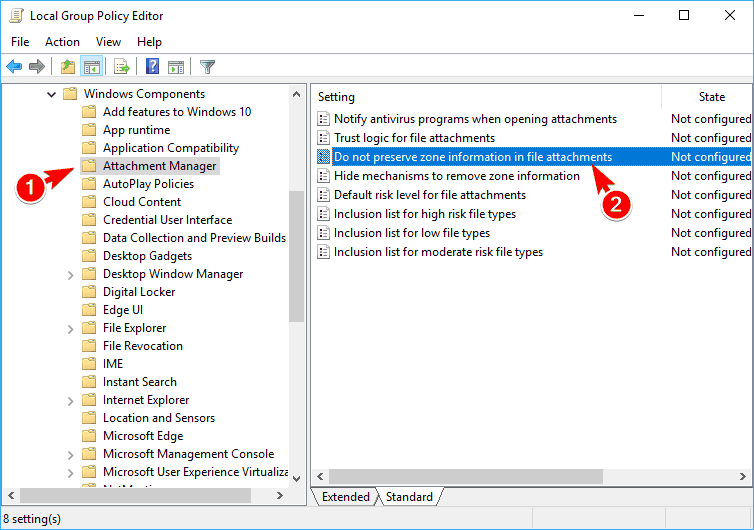
- Select Enabled and click on Apply and OK to relieve changes.
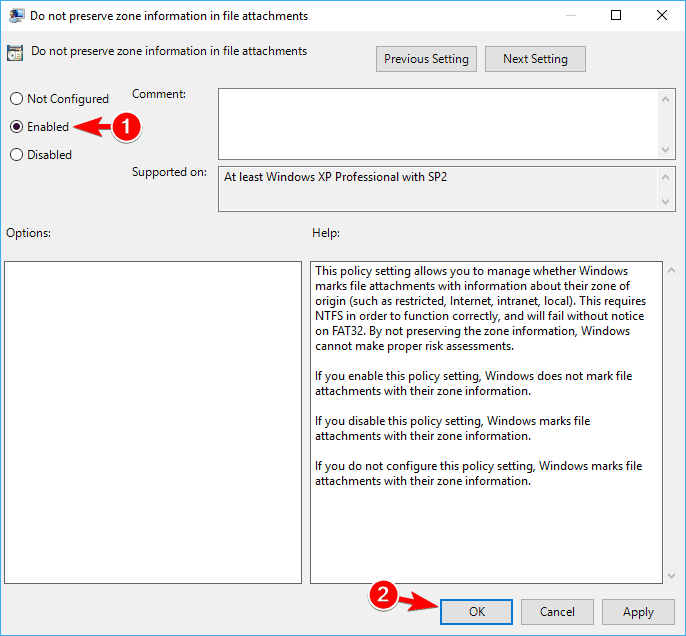
- Now click on the Inclusion listing for low file types.

- Select Enabled and paste the following line in Specify depression-risk extensions input field:
.avi;.bat;.cmd;.exe;.htm;.html;.lnk;.mpg;.mpeg;.mov;.mp3;.mp4;.mkv;.msi;.m3u;.rar;.reg;.txt;.vbs;.wav;.nothing;.7z - Click on Apply and OK to save changes.
You can prevent this security warning from appearing by using Group Policy Editor.
This is a useful application that allows you lot to change various settings, but unfortunately, it'southward available only on Pro and Enterprise versions of Windows.
To use Group Policy, do as described higher up. Close Group Policy Editor and restart your PC. Once your PC restarts, check if the problem still appears.
Cheque our handy guide to hands edit the Group Policy similar a pro.
five. Use Control Prompt
- Press Windows Fundamental + X and choose Command Prompt (Admin) from the menu. If Command Prompt isn't available, y'all tin use PowerShell (Admin) instead.
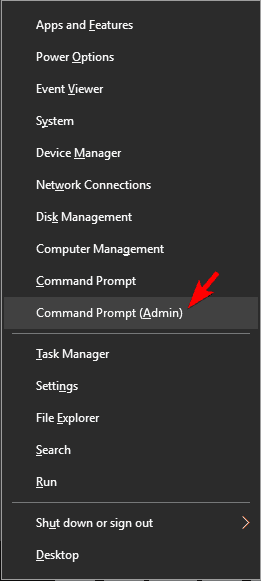
- When Command Prompt starts, enter the post-obit lines:
-
REG Add together "HKCUSoftwareMicrosoftWindowsCurrentVersionInternet SettingsZones3" /Five "1806" /T "REG_DWORD" /D "00000000" /F -
REG ADD "HKLMSoftwareMicrosoftWindowsCurrentVersionInternet SettingsZones3" /5 "1806" /T "REG_DWORD" /D "00000000" /F -
REG ADD "HKLMSOFTWAREPoliciesMicrosoftInternet ExplorerSecurity" /Five "DisableSecuritySettingsCheck" /T "REG_DWORD" /D "00000001" /F
-
You tin can also forbid this security message from appearing by using Control Prompt. Many users don't know this, but you tin can utilise Command Prompt to rapidly edit your registry.
Nosotros accept to warn y'all that modifying the registry tin can be potentially dangerous, so y'all're doing it at your own take a chance. To fix this problem using Command Prompt, do equally described to a higher place.
Afterward commands are executed, you might accept to restart your PC to apply the changes.
Working in Command Prompt volition be like a walk in the park afterwards you read our guide!
6. Unblock the file
- Right-click the problematic file and choose Properties from the menu.
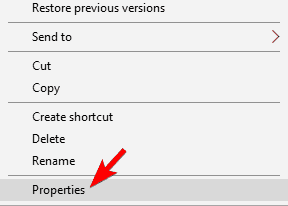
- When the Properties window opens, go to the General tab and click on the Unblock button.
To finish this security warning from appearing, yous might need to unblock your file. Sometimes files can go blocked causing this warning to appear.
To unblock your file, be certain that the file is located in a directory that is associated with your user accounts such as your Desktop or Documents.
If you want to unblock a specific file, complete the above process. After doing that, you won't see the security warning for this file anymore.
7. Uncheck Always inquire before opening this file option
- Run the problematic file.
- You should run into an Open File security alert. Uncheck E'er ask earlier opening this file pick. Now click on Run to continue.

If you lot want to disable Open File security warning for a specific file, you can do information technology simply past unchecking a single selection. To do that, follow the in a higher place procedure.
After doing that, you should be able to open that file without whatsoever security warnings.
This method is simple and straightforward, and it's rather useful if you want to disable this security warning for a specific file.
viii. Accept buying over the problematic file
- Locate the file that is giving you this security warning and right-click it. Choose Backdrop from the carte du jour.
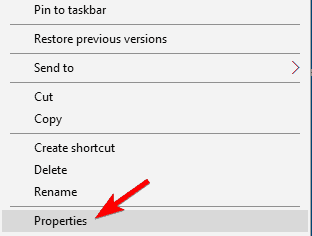
- When the Properties window opens, go to the Security tab and click on Advanced.
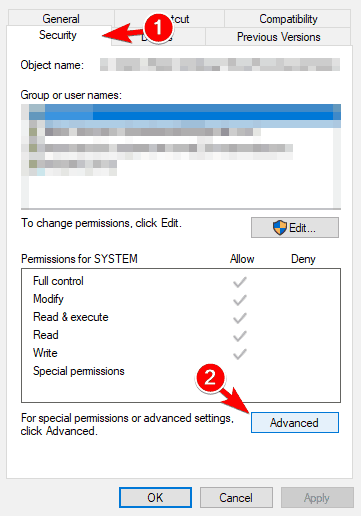
- In the Owner section click on Modify.
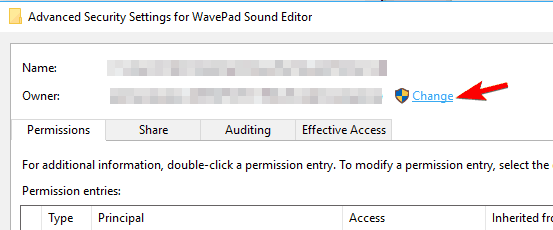
- Select User or Group window will appear. In the Enter the object name to select field enter your user name. At present click on Cheque Names. If everything is in order, click on OK to salvage changes.
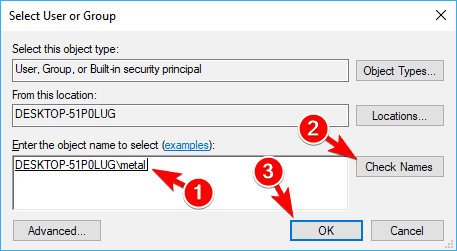
- The possessor of the file should now exist changed. Now you just have to click on Use and OK to relieve changes.
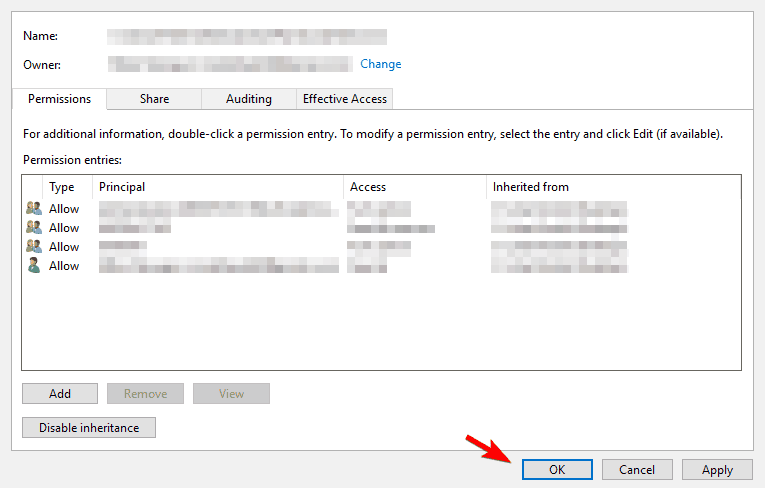
If you lot're getting this security warning on your PC, you lot might be able to disable information technology for a specific file past taking buying of that file.
This is relatively simple, and you tin can do it by following the in a higher place procedure.
Afterwards taking ownership of the file, y'all should be able to run it without whatsoever security warnings. If you're an advanced user, you lot can also use Control Prompt to take ownership of a sure file.
To practice that, just follow these steps:
- Start Command Prompt or PowerShell equally administrator.
- When Command Prompt opens, enter:
- takeown /F <path_to_file>
Of course, be sure to replace the <path_to_file> with an bodily path to the problematic file. This method is faster, only it requires you to enter the exact path to the problematic application.
If you lot're an advanced user and familiar with Control Prompt, experience free to try this method instead.
9. Change Local intranet settings
- Open up Internet Options. Nosotros showed you lot how to do that in Solution ane, so be certain to check it for detailed instructions.
- When the Internet Properties window opens, go to the Security tab and select Local intranet. At present click on the Sites button.

- The local intranet window volition now appear. Click on the Advanced push button.
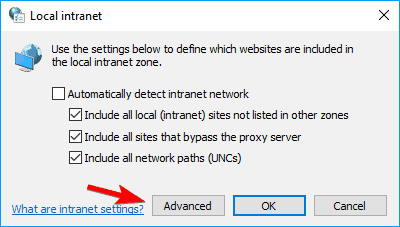
- Now enter the accost of the server in the Add this website to the zone field. You lot tin can use the server'southward domain or you lot can use its IP accost. Just be sure to enter earlier the server's address or domain. Now click on the Add push button. Subsequently you're done adding servers, click the Close button.
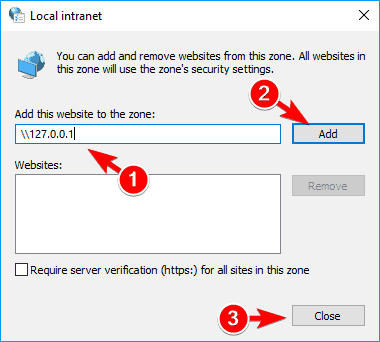
- Save changes and your problem should be resolved completely.
According to users, this security alert can appear if you're trying to run an application from a network directory.
To fix this problem, you lot demand to add the name or the IP address of the server on which the awarding is stored in Intranet settings.
This is relatively simple to do, and y'all can do it by following the in a higher place steps.
If you don't desire to use Cyberspace Options, you can make the same changes using the Group Policy Editor. To practice that, follow these steps:
- Open Group Policy Editor. To see how to do that, check the first step of Solution 4.
- When Group Policy Editor starts, navigate to Compute r Configuration > Authoritative Templates > Windows Components > Net Explorer > Internet Control Panel > Security Folio in the left pane. In the right pane, locate and double click Site to Zone Assignment List.
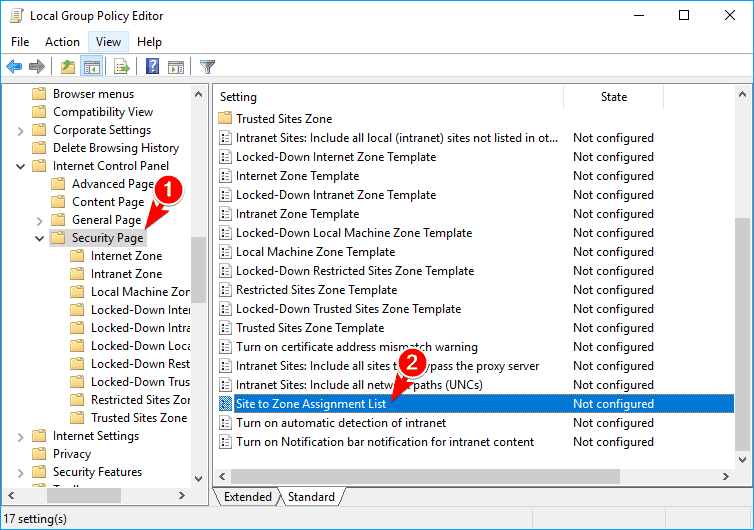
- Now select Enabled and click on the Show button.

- In the Value name column enter the IP accost or domain name of the server. As for Value, enter ane. After you enter all the necessary addresses, click on OK to save changes.
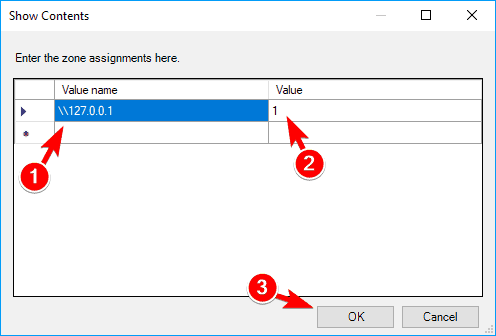
- At present just click on Utilise and OK to employ changes.
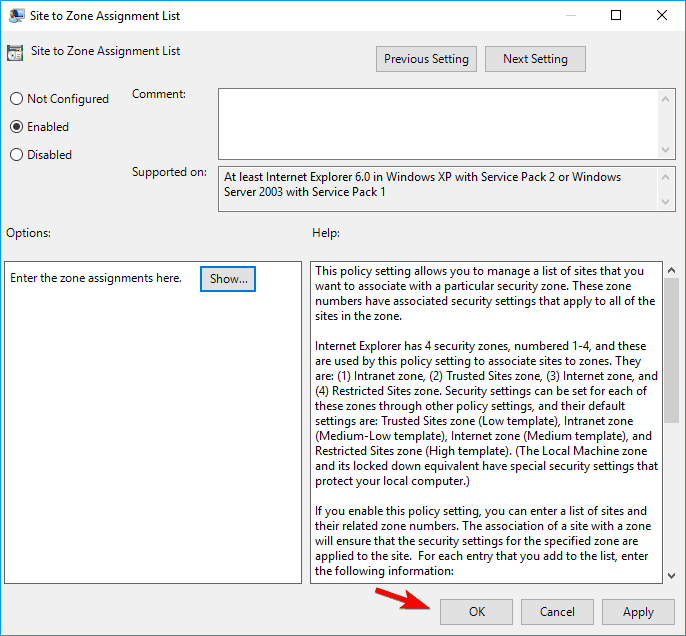
Both methods volition reach the same results, so you lot tin can use any of them. Go on in mind that this solution works only if you lot're trying to run an awarding from a network directory.
10. Employ Command Prompt

- Start Command Prompt every bit administrator.
- Use Command Prompt to navigate to the location of the problematic file.
- Now enter the following commands:
- move your_file_name.exe NewName
- type NewName > your_file_name.exe
If y'all're frequently getting this security warning, y'all might be able to disable it for a specific file by using Control Prompt. To do that you need to follow these to a higher place steps.
This is a solid workaround, and information technology works according to users, so experience gratis to attempt information technology out. Keep in mind that in gild to use this solution you need to have a basic understanding of Control Prompt syntax.
11. Check Include all network paths options
- Open up Net Options. Navigate to the Security tab, select Local intranet, and click on Sites push button.
- The local intranet window will appear. Uncheck all options except Include all network paths (UNCs). Afterwards doing that, click on OK to salve changes.
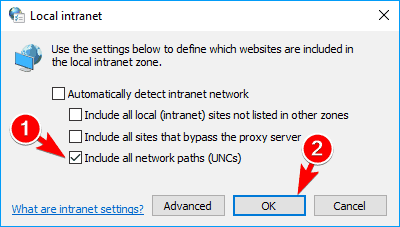
- Optional: Few users propose that you should bank check Include all local (intranet) sites not listed in other zones choice also, so you might want to practise that.
Few users claim that you can set this trouble but by checking a few settings in Net Options. To do that, follow the above process.
After doing that, the trouble should be fixed and y'all'll be able to run files from network directories without any problems.
12. Create a bat file that will run the problematic file
- Open Notepad.
- At present paste the following code:
- start c:windowssystem32 notepad.exe
We used Notepad as an case, merely if y'all want to launch any other application using the bat file, you demand to enter the location of the file betwixt the quotes and the file name subsequently it.
- Now you just have to save your file. To exercise that, go to File > Salve as.
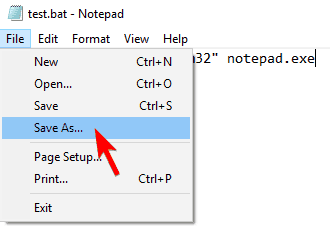
- Set Save every bit type to All Files and enter script.bat as the file proper noun. Now choose the save directory and click the Save push button.

- Now you simply have to locate script.bat file that you created and run it and the awarding will start without whatever security warnings.
According to users, y'all tin can avoid this security warning while running a certain application simply by creating a bat file that will start the application for you lot. To exercise that, follow these steps:
This is a solid workaround, but it might be a chip complicated since you have to create a bat script for that specific file.
Since this is just a workaround, you'll take to utilize the script to starting time the desired application every time.
Schedule batch files similar a real expert! Learn how from our handy guide!
13. Utilize the icals command

- Open Command Prompt every bit administrator.
- When Command Prompt starts, run the post-obit commands one by one:
-
ICACLS "%programdata%MicrosoftWindowsStart MenuPrograms" /Setintegritylevel (OI)(CI)Medium -
ICACLS "%userprofile%FavoritesLinks" /Setintegritylevel (OI)(CI)Medium -
ICACLS "%userprofile%AppDataRoamingMicrosoftInternet ExplorerQuick Launch" /Setintegritylevel (OI)(CI)Medium -
ICACLS "%userprofile%AppDataRoamingMicrosoftInternet ExplorerQuick LaunchUser pinnedTaskbar" /Setintegritylevel (OI)(CI)Medium
-
Several reported this security warning while trying to run applications from Start Card or from the Taskbar.
Co-ordinate to them, you tin can fix this problem only by using the icals command. This is relatively simple and you tin practise it past post-obit the in a higher place steps.
After running these commands the security alert should disappear and you won't see it while trying to run applications from Taskbar or Starting time Menu.
If y'all're having this problem with Desktop shortcuts, y'all might be able to fix information technology by running Command Prompt and using ICACLS C:Users<username goes here>Desktop /Setintegritylevel (OI)(CI)G command.
After doing that, yous should be able to run shortcuts from your Desktop without problems.
14. Download and use streams utility

If you're getting Open File security warning while opening a specific file, y'all might exist able to fix information technology by using streams tools. This tool is a role of Sysinternals and yous can download information technology for gratis from Microsoft'southward website.
After you download the tool, you demand to starting time it manually or use Command Prompt to navigate to its directory and enter the following control:
- streams.exe -accepteula -d <path_to_the_file>application_name.exe
After running this command you'll remove all zone data from that file and you lot won't meet any security warnings while running information technology.
15. Copy the files to a different location

According to users, you might be able to fix the problem with the annoying security warning merely by copying the affected files to a new location.
To practice that, locate the problematic files and select them. Now re-create them to your Desktop.
After doing that, delete the original files from their directory. Now move the files from your Desktop to the original location. After doing that y'all should be able to run those files without any bug.
Users reported that this workaround works with Cyberspace Explorer favorites, but be sure to try it with other files that are giving y'all this security alert.
Files are copied too slow? Bank check our comprehensive guide to solve this issue!
Open File security alarm can be rather annoying at times, but y'all should be able to prevent it from appearing past using ane of our solutions.
Moreover, use them when encountering these similar problems too:
- Open up file security warning we tin't verify who created this file – Solve this rather mutual issue shouldn't be too complicated. Experience free to change your Net options or set up the file location equally a trusted site and see if this makes any difference.
- Open file security alert add trusted locations – Countless users have been constantly trying to solve this issue to absolutely no avail. If y'all're one of them also, the higher up tips are pure gold.
Source: https://windowsreport.com/open-file-security-warning/
Posted by: porrasmishme.blogspot.com

0 Response to "How To Turn Off Windows Security Warning"
Post a Comment